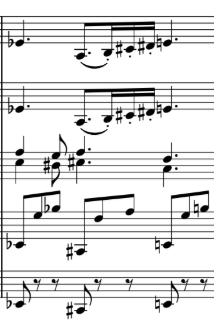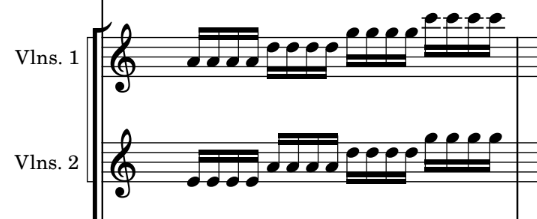All Activity
- Past hour
-
ComposaBoi started following 2 Choral Motets
- Today
-
I believe you're referring to beat 3? I didn't want to spell the Eb major chord as a D# major chord (on account of having to spell the G as an Fx and also because there occur both F#'s as well as G's in the voice leading which are still best understood in the key of E minor). The chord on beat 3 is actually an F# major chord spelled with a Bb instead of an A# (and again, this is done because of voice leading since the Bb leads to an A in the following harmony of B7 with a C# in the bass). You gotta consider that the whole chromatic system is imperfect and often, compromises must be made for the sake of readability and voice leading. Also often, organizing the given pitches into a heptatonic scale with no repeated notes as best one can takes precedence over spelling passing chords on weak beats correctly. Are you referring to the Db major section in measure 258? Db major has 5 flats while C# major has 7 sharps so that was just a practicality and familiarity thing. Some key signatures are preferable to others for practical reasons and are used way more often because of that. That to me justified switching to a flat key even though the tonal center of C# is not that foreign to a piece in E minor, being the relative minor of E major. Yes, that is annoying for sure. Even more so for harp which sometimes needs everything respelled a certain way according to the position of its pedals. But correct me if I'm wrong, but you seem to use scores in concert pitch for your music? That's one way to avoid the trouble in the score, but if you ever need to print out parts you'd still need to transpose it to the correct enharmonic key. Unless you're working with an instrumentalist who is expected to be able to transpose such as Trumpet or French Horn. Thanks for your comments!
-
PeterthePapercomPoser started following Challenge (song) , Atonal Music and the Modern Fugue and My first attempt at a woodwind quartet
-
Henry Ng Tsz Kiu started following Challenge (song)
- Yesterday
-
shirz started following Challenge (song)
-
Could be for a game or a movie idk. maybe this fits more in a movie. This is in piano but I hope you can imagine it as an orchestral cinematic piece like I do. Just not really experienced in arranging orchestral intruments. Maybe Ill do it in the future. I think this is considered a scottish or irish style correct me if i'm wrong. Would love to hear your thoughts. The mistakes in the start are intentional.
-
Thank so much for the warm, kind review.
-
I notice some interesting enharmonic spelling choices. E.g. Bar 32, you've got a Bb minor triad between the celli and violas, spelled with a C# instead of a Db. Then in some places you have lots of flats, and I think you're changing mode here, rather than moving to a different diatonic key? Wondered if it was difficult to choose which spelling to use? Sometimes when my music gets very chromatic, I find I need different spelling in the transposing instruments, which is an added complication! Seems to apply especially to Bb instruments, like clarinet and trumpet.
-
Marc Deflin started following Intervalic piece for Horn and Piano , Rhapsody for Symphony Orchestra , My first attempt at a woodwind quartet and 1 other
-
Rhapsody for Symphony Orchestra
Marc Deflin replied to A Ko's topic in Orchestral and Large Ensemble
Very nice work, sounds huge 🙂 Which soundbank(s) do you use ? -
Hi all 🙂 On vacation doing little treks in the eastern Vosges mountains in France, I profited by my late afternoon free times to give a first try at a woodwind quartet. Here's the result study. I merely structured it as A B ... A B 🙂 and there are one or two harmonic attempts in it. Regards
-
Really enjoyed your piece, @Kvothe Nice melodies, expressiveness, and a story telling writing ; that's what I like in music 👍 Regards
-
Not bad 🙂 Indeed there's a dark, melancholic mood surging out of it.
-
Hi Peter, I took it down because the piece had some direct quotation, and I was worried about copyright issues. I'm actually still working on it, to try and eliminate any recognisable quotation from the original work. Think I'm almost there. If I manage it, will repost. I've also made an orchestration of this work, that I can hopefully post with it.
-
That sounds like a jazz piece with complex chord choices before 03:45 with a tons of synchropation. I actually enjoy it - fresh and energetic Curious what software and prompt/ constraint used to produce this music with AI? That was an abrupt stop though. lol
-
So, I finally convinced AI to perform serial music. If you know, AI is very stubborn in creating everything tonal and consonant. It's good at that, but you can modify midi to be strict and work with AI to create an atonal sound. I like the idea of modern fugues to create a sound of undulating persistence. The sound is deliberate. Though, this fugue is more of a Passaglia, it's within reach. fractal-fugue (46).mid
- 1 reply
-
- 1
-

-
Ok, so to preface, I am in a church choir for a TLM, (and I'm also in the Schola Cantorum so I'm trained to sing the Gregorian chants at Mass, just to brag a little 😏.) Anyway, I was anticipating more traditional style Latin motets, and I'ma be honest with you, the Novus Ordo style with the piano and such makes me really quite uncomfortable, but I said I'd give you some feedback, so I'll try my best. Just beware, I'll probably give very old-fashioned advice with a large bias for Latin Mass aesthetics, so just take what you think is applicable. The Assumption: The voice leading on the SATB part is fine, so no criticism there. I do find the bass part really high though (I am bass myself.) At moderate or louder dynamics like this, it will sound strained, even with higher bass singers. The piano part and flute part I think just add mud and uncomfortable dissonances. The piano part isn't even well written, just looking at it as a pianist myself. Especially since these are supposed to be motets, I'd nix the instrumental parts entirely, except maybe an optional organ reduction. Finally, the engraving is just really... unproffesional. First of all, the tenor should be in treble clef, unless it's a reduced score. I can't imagine trying to read all those ledger lines! The lyric syllables are divided incorrectly, which made it very awkward to read. Here's a guide: Syllable Rules: Divide Into Syllables, and here are all the syllables of this first motet divided properly: Ma-ry is as-sumed in-to heav-en, Moth-er from Earth, now Moth-er of all! Look at the an-gels gaz-ing up-on her, prais-ing our God for the wom-an He made! Al-le-lu-ia, Hail our Queen, Mar-y! Moth-er you passed through the gates, but you're nev-er too far a-way. Will you show us you're near? Hear our prayer! etc. Other engraving nitpicks, page should be portrait not landscape, the scaling should be larger, it's standard and preferable to include the voice range and instrument names, dynamics in vocal music fit better above the staff, and we need a square bracket! I could probably find even more nitpicky stuff if I looked, but this is a good start. Come Holy Spirit: The plain song bit makes this a little more tolerable, but a suspended cymbal in liturgical music?? 😭 I digress. The voice leading here is also fine.And I echo the criticisms of pateceramics, competent choirs will stagger long held notes, regardless of instruction in the score. And the part about the Gregorian chant being off meter. If you do this, please write it unmetered or with partial barlines like in actual chant notation on just that staff, and in each of the other voices just have one whole note under the entire chant solo. If that doesn't make sense, I can sketch up an example for you, but that should be clear. This is also an engraving problem btw, so as you improve your engraving skills, you'll learn how to engrave less commonplace moments like this. What I explained is just what I would do, but there are certainly other ways to handle it. Both these motets, but especially this one, have the issue of feeling stagnant to me. Like they sit in the same I-IV-V range of the tonic key and really don't move anywhere else. This isn't necessarily a bad thing, but it makes for music that can sound uninspired and unoriginal. Sorry if this all is too harsh, I promise it's in good faith and I hope you are able to take this criticism to heart and let it help you improve as a composer. God bless, my friend.
-
Yeah honestly your analysis is gonna be so much better than mine cus I'm not really familiar with the themes (even though I did try to check out the mock-up beforehand), and there are so many of 'em I kept hearing and seeing the similarities but ended up overwhelming myself. That's why I put "Random things I've noticed" since it's really not a full in-depth analysis, more like "oooooohh this section is from that section but some things are different" You've read me. It sounds weird but like it's much more easier for me when it comes to working with pre-existing themes. I did start another piece in the middle of working on my variations. It's a fully original solo piano suite to contrast the tons of orchestration that I have to do, and it's for me to actually compose my own themes. But yeah, you're welcome!
-
Thanks @ferrum.wav and @Alex Weidmann for your reviews! I really admire your attention to detail and delving into the score in reviewing the piece ferrum! But, there is actually another way to analyze the thematic associations in the piece, by realizing their relation to the original themes from the game! This section uses a pairing of two similar themes: The top voice is from the Fight Theme; while the bottom is from Terra's Theme. The themes are so similar to each other when lined up metrically to start at the same time they have almost the same contour. This section is built up from canonic imitation layering of Terra's Theme over itself in four voices. The horn part: is a melody that is also from the latter half of Terra's Theme. This section is a 6/8 variation of the fanfare from the Returner's Theme: This section is also a 6/8 variation of the quartal accompaniment in the Fight Theme: This melody is from the latter half of the Mt. Kolts Theme: Thanks a lot for your detailed review and I am really glad that you're inspired to continue your variations through listening to this! I think you and I have a certain affinity in our compositional styles through our desire to write new music on pre-existing themes and vary them. Thanks again! Thanks! Yes, it was. The only way I managed it is to keep everything mostly in the same key that way the different variations were modularly compatible with each other and I could try to fit them together like puzzle pieces. But that does come with disadvantages, I think. I remember listening to that work! I don't remember if I reviewed it or not. But, it wasn't from FF VI but from another installment in the series, right? I think I was almost too greedy in my ambition with this project. Having included 8 different themes in a variations piece, I almost bit off too much than I could chew so to speak. The project really seemed at many times to be too big for my ability to manage all the different themes and variations. And it's not done yet! Thanks again for your review!
-
The Schola Cantorum Discordiensis is a discord server focusing on early music! (More specifically in the server, up to the 19th century). We have a bunch of cool things, gaming, compositions, monthly challenges, competitions, memes... And many more! Currently the server is very small, about 150 members, my goal is to get to atleast 500. Join us!
- Last week
-
sorry i mean horror 1!
-
horror 3 was supposed to be a chase but it didn't sound that good so I reworked (not cleaned) it.
-
Man the woodwinds writing on this is insane, heck I think the woodwinds are the spotlight of this movement (and the horns too). You've managed to really use all of the family's characteristics to their fullest. Love the canon woodwinds-only section on b.42 for contrast, followed immediately by another color contrast on b.58 by the string quartet and the horn for pedal tones. It's really dense with the variety of themes playing counter-points with each other. The harmonies are so colorful, also really like the transitions between the variations. Random things I've noticed: brass fanfare interruptions on b.228 are from the beginning (b.17), the upward fourths figure from the cellos on b.72 gets a lot of variations after this as foreground (starting b.89), middleground (tremolo strings from b.101), background (b.97), and cadence (b.86 violins, b.126-127 clarinets and oboes, b.135 strings, b.142-145 strings), figure from b.81 by string and oboes gets variated on b.166 (love this section) and b.258, the arpeggiated power chord figure on the harp gets used a lot until the end. Overall, I really like it. Thanks for recommending me your piece! This really motivates and inspires me to continue my own symphonic variation.
-
Hello Sameul, Shall we talk about the sinister colors of this atonal this piece? For there are many! I love dark piano acc., which follows that lush, lost violin line. It daunts us as listener to ever so much. Not many know the powers of atonal music. Here, you have master done that! Kudos.

.thumb.png.8b5b433a341551e913a34392660bc95b.png)













.thumb.png.f5c7c1a6a554eeeefdce321d089f5901.png)